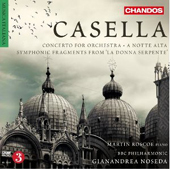

Upon mention of the title "Concerto for Orchestra", the composer that inevitably and automatically springs to mind first is Béla Bartók.
And I would have to say rightly so, as his work bearing that title is a masterpiece in the form, and is now a conventional and commonplace ticket seller for orchestras
around the world. But Bartók did not coin the title or come up with the concept first, as many people believe. Many other composers also wrote a Concerto for Orchestra,
some even more than one, and quite a few, including Casella, even before Bartók scored his own in 1943. Hindemith, Laderman, Tower, Brian, Lutoslawski, Gerhard,
Rouse, Hoddinott, Shchedrin, Kodaly, Piston, Dun, Carter, Tansman, McCabe, Kancheli, Musgrave, Danielpour, Lazarof, Gould, Sessions, Petrassi, Tippett, Hovhaness,
Payne, Husa, Skrowaczewski, Pilati, Szeligowski, Babbitt, Saxton, Liebermann, Stucky, Gregson, Malipiero, Bacewicz, Lindberg, Higdon, Holloway and Zbinden, have all
written pieces bearing the title. Based on this list, the one thing that is clear is that the Concerto for Orchestra is a 20th century invention, although the Concerto Grosso
from the Baroque period, could be interpreted as its smaller scale precursor.
Italian composer Alfredo Casella (1883-1947) wrote his Concerto for Orchestra, Op. 61 in 1937, six years before the
Bartók. It was written for the 50th anniversary celebrations of the Concertgebouw Orchestra of Amsterdam in 1938. And unlike the Bartók whose first few pages are
some of the gloomiest in the repertoire, it bursts open with a festive fanfare that instantly makes clear Casella's orchestration talents, as well as his fondness for flexing
orchestral muscle. Its first movement alone, subtitled Sinfonia, must have been quite a technical challenge to the 1938 Concertgebouw under the baton of
Mengelberg, as I'm sure it must still be quite the learning curve for even today's orchestral standards. Each and every orchestral section is put to the test here, but the
brass players in particular have to surmount some obvious virtuosic passages. Throw in some beautifully lyrical string playing in the middle section of the movement,
and this short movement alone proves an orchestral showcase. The second movement, Passacaglia, just like the famous Bach counterpart, is based on a
repetitive ground bass played by the cellos and double basses, over which the other instruments of the orchestra variate, extrapolate, and everything else in between.
The final movement, Inno, with tempo indications like 'Allegro impetuoso ed animato' and 'Animato e festoso' revisits the hustle and bustle of the first,
including a substantial piano part, and ends the whole work on a high note with Casella's usual orchestral sparkle. This is a world premičre recording.
This new CD also presents two other works by Casella, the Symphonic Fragments from 'La donna serpente', Op. 50 and
A notte alta, Op. 30. The 'La donna serpente' (The Serpent Woman) in particular, based on a fable by the same author who penned Turandot
and Love for Three Oranges is an imaginative work, brilliantly colored, with hints of the exotic ŕ la Rimsky-Korsakov. It sways from moments of quiet, melancholic
beauty to heights of serious sonic muscle. The final battle in particular demands 110% effort and conviction from every member of the orchestra, from the percussion
instruments to the piccolo. It's a true orchestral spectacular.
And of course, as in their previous recording of Casella's Second Symphony, reviewed here,
the BBC Philharmonic and conductor Gianandrea Noseda get right into the thick of things and bring out all of this music's punch,
beauty and effulgence.
Jean-Yves Duperron - July 2012